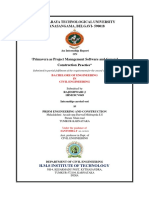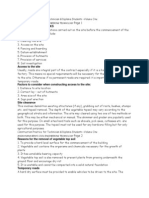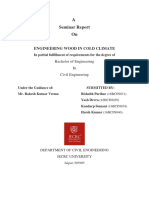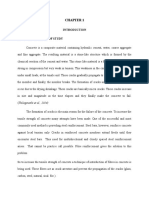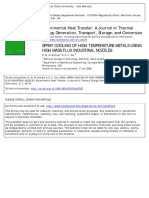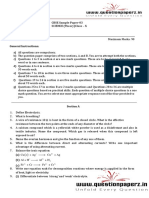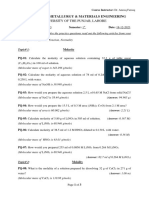Lecture 5.1 - Design Mechanical Properties
Lecture 5.1 - Design Mechanical Properties
Uploaded by
Fatimah Binti Abd RahmanCopyright:
Available Formats
Lecture 5.1 - Design Mechanical Properties
Lecture 5.1 - Design Mechanical Properties
Uploaded by
Fatimah Binti Abd RahmanOriginal Title
Copyright
Available Formats
Share this document
Did you find this document useful?
Is this content inappropriate?
Copyright:
Available Formats
Lecture 5.1 - Design Mechanical Properties
Lecture 5.1 - Design Mechanical Properties
Uploaded by
Fatimah Binti Abd RahmanCopyright:
Available Formats
SELECTION OF PLASTICS
The previous lecture has given an indication of the range of plastics
available to the design engineer.
How do we decide which plastic, if any, is best for a particular application?
FIRST steps in the design process are to define clearly the purpose
and function of the proposed product and to identify the service environment.
Then to assess the suitability of a range candidate materials.
The most important characteristic for engineering components:
Mechanical properties-strength stiffness, fatigue and toughness
Corrosion susceptibility
Special properties; permeability, thermal, electrical, optical,
damping capacity etc
Method of fabrication
Cost and manufacturing route
MECHANICAL PROPERTIES
1. Tensile,
2. Stress
3. Strain
4. Young Modulus, E
storage and loss modulus,E' and E
3. Shear Modulus, G
-storage and loss modulus, G' and G
Stress
A
F
= o = Normal
A
F
= t = Shear
Tension: o>0 Compression: o<0
F F
F
A A
A
Strain
o o
o
l
l
l
l l A
=
= c = Strain u = = = tan
h
a
strain Shear
l
o
l
l
o
l h
a
u
Simple Shear Deformation
t =
F
A
h
x(t)
u
1 A x(t)
h A t
Strain =
x(t)
h
Strain Rate =
. V
h
Shear Modulus G =
t
V
y
x
A
z
Shear Deformation
=
Shear Flow
Shear Stress, Shear Strain, Shear Rate
Stress: Force per unit area.
Symbol: t Units: Pa (SI) or dynes/cm (cgs)
Shear Strain: Relative deformation in shear.
Symbol: Units: None (is displacement over
height)
Shear Rate: Change of shear strain per unit time.
Symbol: Units: [1/s] = s
-1
Tensile Test (ASTM D638)
length
width
thickness
Control length (l)
Measure force (F) with load cell
o o
o
l
l
l
l l A
=
= c = Strain
t w
F
A
F
= = o = Stress
Reduced section used to limit
portion of sample undergoing
deformation
Stress-Strain Curve
S
t
r
e
s
s
Strain
Ultimate Tensile Strength
Yield Point
Slope = E (Youngs Modulus)
Percent Elongation
(total plastic deformation)
Elastic Limit
Proportionality
Limit
Force decreases due to necking
Stress-strain Behavior of Polymers
Brittle
Plastic
Highly elastic
Do not like ceramics and metals, polymer materials exhibit
Various stress-strain behaviors, ranging from very brittle to highly
deformable
Modulus of elasticity ~7MPa to 4GPa.
Plastic elongation can be >100%
very sensitive characteristics to strain rate, temperature, chemical
environment
Ductile
Definition and Terminology used
Toughness from the Area of Tensile Tests
1. Tensile Strength and Strain at Break
0
A
F
= o
The stress, o, and strain, c, can be
calculated as follows:
A
0
is the initial cross-sectional area.
Strain, c
i
is defined as
0
0
) (
l
l l
i
i
= c
Tensile Tests
2. Young's Modulus
c
o
c o
d
d
E
0
0 ,
lim
=
=
The modulus, E value, was calculated using a polynomial curve-fit
(power of 5) on the stress-strain data over the first 1-2 % strain
3. Toughness
This parameter is the energy for failure or rupture energy.
The energy or work of failure can be written as
}
=
break
l
l
Fdl W
0
(1)
Tensile Tests
If both sides of equation (1) are divided by A
0
, which will
bring o
0
into the relationship, and realizing that
0
l
dl
d = c
(2)
( )
0
0 0
0
l d
A
F
A
W break
l
l
c
} |
|
.
|
\
|
=
}
= =
b
d
V
W
l A
W
c
c o
0
0 0 0
The tensile toughness can be calculated from the integral
of the stress-strain curve that is the energy of rupture normalized
per unit volume, V
0
of the initial sample.
(3)
Tensile response: brittle and rigid
Crosslinked or networked polymers
(e.g. thermoset)
Tensile response: elastomers (rubbery)
Heavily crosslinking => alignment &crystallization difficult
Tensile response: plastic
Upper yield pt
lower yield pt
Semi-crystalline polymers (linear or branched)
(e.g. thermoplastic)
Elastic region Neck formation Elongation
Compare to metals:
Deformation is confined
within the neck region
Stretching of
covalent bond
Chains aligned
Neck propagation, localized
crystallization -strengthening
Molecular weight, TS
Crystallinity, TS
Drawing, TS (introduce deformation during process)
Annealing, TS
Highly Temperature Dependent Near Room Temperature
Polymer (PMMA)
Metal (Iron)
As T increases:
E decreases
TS decreases
Ductility increases
-200
o
C~25
o
C
4
o
C~60
o
C
W = load at a given point on the load deflection curve, (N)
L = Support span, (mm)
b = Width of test beam, (mm)
d = Depth of tested beam, (mm)
FLEXURE (BENDING) three point bending
ASTM D790
A
W
0
L
o
c
o
0
AL
Wo
stress, =
strain, =
modulus, E =
=
In flexure (bending) situations, these equations
do not apply. For the three point bending loading
In tensile analysis:
=
the relevant equations are:
stress, =
I
My
Where M = bending moment at loading point (=WL/4)
y = half depth of beam (= d/2)
I = second moment of area (bd3/12)
hence stress, =
2
2
3
bd
WL
deflection =
EI
WL
48
3
|
|
.
|
\
|
=
|
|
.
|
\
|
d
L
Ed
L
6 6
2 2
c o =
Hence strain, = |
.
|
\
|
2
6
L
d o
c
o
o
3
3
4bd
WL
Modulus, E =
=
Material Density
(kg/m
3
)
Tensile
Strength
(MN/m
2
)
Flexural
Modulus
(GN/m
2
)
%
Elongation at
break
Price*
ABS 1040 38 2.2 8 2.1
Acrylic 1180 70 2.9 2 2.5
Cellulose acetate 1280 30 1.7 30 3.2
Epoxy 1200 70 3.0 3 8.3
Nylon 66 1140 70 2.8 60 3.9
PEEK 1300 60 3.8 4 42
PET 1360 75 3 70 3
Polycarbonate 1150 65 2.8 100 4.2
Polyethersulfone 1370 84 2.6 60 13.3
Polyimide 1420 72 2.5 8 150
polypropylene 905 33 1.5 150 1
Polysulfone 1240 70 2.6 80 11
PTFE 2100 25 0.5 200 13.3
Polystyrene 1050 40 3 1.5 1.1
LDPE 920 10 0.2 400 0.83
HDPE 950 32 1.2 150 1.1
PVC (rigid) 1400 50 3 80 0.88
PVC (flexible) 1300 14 0.007 300 0.92
DMC (Polyester) 1800 40 9 2 1.5
SMC (Polyester) 1800 70 11 3 1.3
Short-term properties of some important plastic
Taken from; RJ Crawford in Plastics Engineering, 3
rd
Edition,1998, Butterworth Heinemann, p23
* On a weight basis, relative to polypropylene
Sheet moulding compound - SMC
Dough moulding compound - DMC
Material Selection for Strength
In service, a material is required to have a certain strength in order to
perform its function satisfactorily then a useful way to compare the
structural efficiency of a range of materials is to calculate their strength
desirability factor.
Consider a structural member which is essentially a beam subjected to
bending (Fig 1).
Irrespective of the precise nature of the beam loading the maximum stress, ,
in the beam will be given by:
b
d
L
= =
I
d M ) 2 / (
max
o
12 /
) 2 / (
2
max
bd
d M
. (1.1)
Assuming that we are comparing different materials on the basis that the
mean length, width and loading is fixed but the beam depth is variable
then equation (1.1) may be written as:
=
1
/d
2
(1.2)
where
1
is a constant
But the weight, w, of the beam is given by
w = bdL . (1.3) (1.3)
So substituting for d from (1.2) into (1.3)
w =
2
/
1/2
(1.4)
where
2
is the same constant for all materials.
Hence, if we adopt loading/weight as a desirability factor, D
f
, then this will be given by
Where
y
and
are the strength and density values for the materials being compared.
Similar desirability factors may be derived for other geometries such as struts,
columns etc.
o
2 / 1
y
f
D =
(1.5)
(1.2)
Material Selection for Stiffness
If in the service of a component it is the deflection, or stiffness,
which is the limiting factor rather than strength, then it is necessary
to look for a different desirability factor in the candidate materials.
Consider the beam situation described above. This time, irrespective
of the loading, the deflection, , will be give:
(1.6)
where 1 is a constant and W represent the loading.
The stiffness may be expressed as:
=
1
|
|
.
|
\
|
EI
WL
3
|
|
.
|
\
|
1
1
o
3
L
EI
=
o
W
( )
3
2
Ed
W
o
o
= (1.7)
where
2
is a constant and again it is assumed that the beam width and length
are the same in all cases.
3
1
/
3
E w o =
Once again the beam weight will be given by equation (1.3) so substituting for d
from equation (1.7)
(1.8)
Hence, the desirability factor, D
f
, expressed as maximum stiffness for
minimum weight will be given by
3 / 1
E
D
f
=
Where E is the elastic modulus of material in question and is the density
A ball point pen made from polypropylene has a clip design shown in Fig. 5.1
When the pen is inserted into a pocket, the clip is subjected to a deflection of
2 mm at point A. If the limiting strain in the material is to be 0.5 % calculate
(i) a suitable thickness, d, for the clip
(ii) the initial stress in the clip when it is first inserted into the pocket and
(iii) the stress in the clip when it has been in the pocket for 1 week.
The creep curves in Fig. 5 may be used and the short term modulus
of polypropylene is 1.6 GN/m2.
PROBLEM 5.1
2.4 mm
40mm
d
Width
6 mm
Figure 5.1
d
w
L
PROB LEM 5.2
A Polypropylene beam is 100 mm long, simply supported at each end and is
subjected to a load W at its mid span. If the maximum permissible strain in
the material is to be 1.5%, calculate the largest load which may be applied
so that the deflection of the beam does not exceed 5 mm in a service life of
1 year. For the beam I = 28 mm4. and the creep curves in Fig. 5 should
be used
L
o
W
Permeability
The low density of plastics is an advantage in many situations but the relatively
loose packing of the molecules means that gases and liquids can permeate
through the plastic.
This can be important in many applications such as packaging or fuel tanks.
It is not possible to generalize about the performance of plastics relative to each
other or in respect to the performance of a specific plastic in contact with different
liquids and gases.
Some plastics are poor at offering resistance to the passage of fluids through
them whereas others are excellent.
Their relative performance may be quantified in terms of a permeation
constant, k, is given by
Atp
Qd
k =
Where Q = volume of fluid passing through the plastic
d = thickness of plastic
A = exposed area
t = time
p = pressure different across surfaces of plastic.
The main fluids of interest with plastics are oxygen and water vapour
(for packaging applications) and CO2 (for carbonated drinks applications)
In some cases it is necessary to use multiple layers of plastics because no single
plastic offers the combination of price, permeation resistance, printability, etc.
required for the application
When multi-layers are used, an overall permeation constant for the composite wall :
=
=
=
N i
i
i
k
di
d k
1
1 1
You might also like
- Signal Transduction Pathways POGIL Answer KeyDocument6 pagesSignal Transduction Pathways POGIL Answer KeyJacob Rogers100% (6)
- Vanda 2020 Grade 8 + AKDocument17 pagesVanda 2020 Grade 8 + AKkusniar deny permanaNo ratings yet
- Demo Lesson PlanDocument7 pagesDemo Lesson PlanJohnryl Bayking Garzon56% (9)
- Floods and Flood Management in PakistanDocument11 pagesFloods and Flood Management in PakistanAbbas WarsiNo ratings yet
- Three Point Flexural TestDocument3 pagesThree Point Flexural Testjerfmos100% (1)
- Finite Element MethodDocument20 pagesFinite Element MethodRajeshNo ratings yet
- Drilling Report JessicaDocument14 pagesDrilling Report JessicaJéssica RamalhoNo ratings yet
- Lab 3Document6 pagesLab 3Anonymous eGc6IFJc8G0% (1)
- Three-Point Flexural TestDocument3 pagesThree-Point Flexural TestBassey Okon100% (1)
- Faculty of Engineering and Science MAEN 1000: Engineering Materials Lab Report Cover SheetDocument18 pagesFaculty of Engineering and Science MAEN 1000: Engineering Materials Lab Report Cover SheetPanadol PanadolNo ratings yet
- Expt 4b.flexure TestDocument5 pagesExpt 4b.flexure TestVishwasVerma100% (1)
- Mec291 Manual Lab Edited Mac 2019Document54 pagesMec291 Manual Lab Edited Mac 2019Ammar ArfanNo ratings yet
- Flexural or Bending Test Lab ReportDocument9 pagesFlexural or Bending Test Lab ReportAman NigamNo ratings yet
- Engineering Mechanics 1 LabDocument4 pagesEngineering Mechanics 1 LabZiyad RazaliNo ratings yet
- 05 BoQ TenderDocument15 pages05 BoQ Tenderlucio444No ratings yet
- Organic Soils: BY Roaa Monam FadhilDocument18 pagesOrganic Soils: BY Roaa Monam Fadhilroaa100% (1)
- Final Report - 2008 - 10 - 27Document81 pagesFinal Report - 2008 - 10 - 27jarrydNo ratings yet
- Unit 3 - Construction Site Selection Criteria Assignment 08-05-20Document7 pagesUnit 3 - Construction Site Selection Criteria Assignment 08-05-20Rob PageNo ratings yet
- Material ReportDocument20 pagesMaterial Reportfirstman31100% (1)
- Numerical ModelingDocument41 pagesNumerical Modelingntuten88No ratings yet
- Water Resources PlanningDocument26 pagesWater Resources PlanningAku MattNo ratings yet
- Wood Bending PDFDocument11 pagesWood Bending PDFprasanna020391100% (1)
- Debashis WadadarDocument20 pagesDebashis WadadarDebashis Wadadar100% (1)
- Visvesavaraya Technological University Jnanasangama, Belgavi-590018Document41 pagesVisvesavaraya Technological University Jnanasangama, Belgavi-590018Hemalata HosamaniNo ratings yet
- Fibre Reinforced ConcreteDocument11 pagesFibre Reinforced Concretesyedqumbar100% (1)
- Construction Practice 1 For TechnicianDocument24 pagesConstruction Practice 1 For TechnicianMichael_Mensah_2238No ratings yet
- Asif ProjectDocument217 pagesAsif ProjectAnonymous Kpx9F0ANo ratings yet
- Vinaza ViscosidadDocument8 pagesVinaza ViscosidadPatricia J ÁngelesNo ratings yet
- Failure Analysis in Material ScienceDocument7 pagesFailure Analysis in Material SciencemaylynXiXNo ratings yet
- Chapter - HydrogeologyDocument37 pagesChapter - HydrogeologyMohd Syafiq AkmalNo ratings yet
- Semnar ReportDocument32 pagesSemnar ReportRishabh Parihar0% (1)
- 1.explain The Following Types of Distribution Systems : (A) Dead EndDocument15 pages1.explain The Following Types of Distribution Systems : (A) Dead EndMichael LangatNo ratings yet
- Mechanical PropertiesDocument57 pagesMechanical PropertiesElmedin Gluhic100% (1)
- CHAPTER 1 FINAL YEAR ProjectDocument5 pagesCHAPTER 1 FINAL YEAR ProjectdejayzNo ratings yet
- Exam Applied Hydro Geology 0405Document11 pagesExam Applied Hydro Geology 0405deshmukhgeolNo ratings yet
- Rational Method Hydologic Calculations With Excel CourseDocument20 pagesRational Method Hydologic Calculations With Excel Coursesyammc100% (1)
- Cubical DilationDocument5 pagesCubical DilationChintu Kishen KMNo ratings yet
- MOS-I (Lecture-2)Document17 pagesMOS-I (Lecture-2)Khalid YousafNo ratings yet
- Project Report TRPDocument11 pagesProject Report TRPgoyalneerajNo ratings yet
- HydrologyDocument4 pagesHydrologyRafia AbidNo ratings yet
- Viscosity: Submitted To:-Mr. Rahul Agarwal Submittted By:-Suraj KumarDocument12 pagesViscosity: Submitted To:-Mr. Rahul Agarwal Submittted By:-Suraj KumarRohit SinghNo ratings yet
- Ubc 2017 November Moudgil Manu (Factibilidad Estructural)Document107 pagesUbc 2017 November Moudgil Manu (Factibilidad Estructural)Sebastián BerwartNo ratings yet
- Pme 310 1Document9 pagesPme 310 1Anonymous 72KAVTrQTANo ratings yet
- Chemical Oxygen DemandDocument22 pagesChemical Oxygen DemandAnonymous MqTzKsp7100% (1)
- A) What Is Quantity SurveyingDocument21 pagesA) What Is Quantity SurveyingShivani KothawadeNo ratings yet
- Water Resources DipitDocument32 pagesWater Resources Dipitvineet_knwr100% (1)
- Lab #10: Dissolved Oxygen Levels in Natural Waters: Date: Name: Student Id: Co-WorkerDocument5 pagesLab #10: Dissolved Oxygen Levels in Natural Waters: Date: Name: Student Id: Co-WorkerCuong NguyenNo ratings yet
- Complete Report Progress - PDFDocument50 pagesComplete Report Progress - PDFNik Izzati Nik RazaliNo ratings yet
- Steel Fiber Reinforced ConcreteDocument9 pagesSteel Fiber Reinforced Concretespiridisp100% (1)
- Lab Manual Mechanic of Materials SEM 2 20132014Document65 pagesLab Manual Mechanic of Materials SEM 2 20132014saruwatari michiyo100% (1)
- Viscosity ReportDocument11 pagesViscosity ReportMuhammad Farooq100% (1)
- Chapter - 1 EIADocument68 pagesChapter - 1 EIANatnael AberaNo ratings yet
- 1 Introduction WREDocument36 pages1 Introduction WREashwin_khandelwal24No ratings yet
- Rock Failure CriteriaDocument18 pagesRock Failure CriteriaNikhil SinghNo ratings yet
- Al Falaj (Autosaved)Document18 pagesAl Falaj (Autosaved)Cacai GariandoNo ratings yet
- Water ResourcesDocument27 pagesWater Resourcessharon ranjitha paulNo ratings yet
- Viscosity of Fluids Lab Ball Drop MethodDocument4 pagesViscosity of Fluids Lab Ball Drop MethodNOKIANo ratings yet
- Strength of Materials - PUPDocument60 pagesStrength of Materials - PUPshirelyna100% (1)
- Tension TestDocument7 pagesTension TestmanmathkNo ratings yet
- Mechanical Behavior of Materials: Tensile TestingDocument34 pagesMechanical Behavior of Materials: Tensile TestingSebut Saja IrwanNo ratings yet
- Experiment 2Document2 pagesExperiment 2Ahmetgözde GözdeahmetNo ratings yet
- Simple Stress StrainDocument141 pagesSimple Stress StrainvelavansuNo ratings yet
- MOS QBDocument16 pagesMOS QBRoger FedererNo ratings yet
- SVU42644984-7524-Strength of MaterialDocument11 pagesSVU42644984-7524-Strength of MaterialMohit singhNo ratings yet
- Class NoteDocument33 pagesClass NoteAnshuman MukherjeeNo ratings yet
- Atlas Anti Scale SystemsDocument16 pagesAtlas Anti Scale SystemsCiprian-Bogdan MihalacheNo ratings yet
- Modul FisTan 1Document45 pagesModul FisTan 1RafliNo ratings yet
- PP CT20 - Borealis Bormod Bf970moDocument3 pagesPP CT20 - Borealis Bormod Bf970moarmandoNo ratings yet
- 2ND Year - Electrical and Electronic Engineering MaterialDocument3 pages2ND Year - Electrical and Electronic Engineering MaterialDipesh ChaudharyNo ratings yet
- Food Contact Compatibility SafetyDocument160 pagesFood Contact Compatibility Safetypratema ricoNo ratings yet
- Don't Gamble With Safety On Chemical TankersDocument14 pagesDon't Gamble With Safety On Chemical TankersHenryNo ratings yet
- Annular Bop Packing Elements: Otu Se (Axs)Document2 pagesAnnular Bop Packing Elements: Otu Se (Axs)JoseManuelDominguezHuertaNo ratings yet
- Experimental Heat Transfer: A Journal of Thermal Energy Generation, Transport, Storage, and ConversionDocument18 pagesExperimental Heat Transfer: A Journal of Thermal Energy Generation, Transport, Storage, and ConversionEduardoNo ratings yet
- Plexiglas General Information and Physical PropertiesDocument24 pagesPlexiglas General Information and Physical PropertiesCornel N. ŞeitanNo ratings yet
- Checklist For Fireextinguisher As Per IsDocument2 pagesChecklist For Fireextinguisher As Per IsQhsef Karmaveer Jyoteendra VaishnavNo ratings yet
- CBSE 10th Science Sample Paper 2Document6 pagesCBSE 10th Science Sample Paper 2Aditya AcharyaNo ratings yet
- Grundfosliterature 2950863Document82 pagesGrundfosliterature 2950863Paris AnabelNo ratings yet
- Statement Type Questions-1Document17 pagesStatement Type Questions-1Swastik DasNo ratings yet
- Catalog of Channel LettersDocument46 pagesCatalog of Channel LettersauNo ratings yet
- Total Dissolved Solids, Turbidity and Water ClarityDocument34 pagesTotal Dissolved Solids, Turbidity and Water ClarityMayette Rose SarrozaNo ratings yet
- Power Plants Programme 2014Document138 pagesPower Plants Programme 2014sbiliristhodNo ratings yet
- HISTOLOGY LaboratoryDocument5 pagesHISTOLOGY LaboratoryFarida GuialelNo ratings yet
- Boundless Physics: Radio WavesDocument29 pagesBoundless Physics: Radio WavesYollyNo ratings yet
- PP Aaa PP1 114Document49 pagesPP Aaa PP1 114Rabah AmidiNo ratings yet
- Class 8 Practice Paper-S and M...Document9 pagesClass 8 Practice Paper-S and M...jacob100% (3)
- Material Safety Data Sheet - BasecoatDocument3 pagesMaterial Safety Data Sheet - BasecoatJM SubionNo ratings yet
- Guidelines Environmental Monitoring Municipal Solid Waste LandfillsDocument60 pagesGuidelines Environmental Monitoring Municipal Solid Waste LandfillsCarren MarquezNo ratings yet
- API 1104 Reading ChecklistDocument2 pagesAPI 1104 Reading Checklistbacabacabaca100% (2)
- CELLCLEAN U - PI - 1609 - enDocument1 pageCELLCLEAN U - PI - 1609 - enNicole LaLaNo ratings yet
- Practise Questions-Set-3 2023Document3 pagesPractise Questions-Set-3 2023muzammil3969No ratings yet























